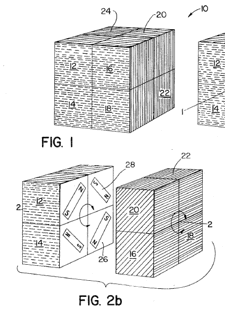 |
| |
A Colorful Journey through Endless Patterns of Quick Wits |
|
|
|
|
|
|
|
Home
/
Masters
/
Larry D. Nichols |
|
|
|
|
|
|
|
|
|
Dr. Larry D.
Nichols, a lifelong puzzle enthusiast and inventor,
grew up in Xenia, Ohio, and studied chemistry at
DePauw University in Greencastle, Indiana, before
moving to Massachusetts to attend Harvard Graduate
School. He has lived with his wife Karen in Arlington,
Massachusetts, for the last forty years, and is now
retired. Their two sons live in Burlington, Vermont,
and San Jose, California. |
|
|
|
|
 |
Larry Nichols' Cube
as it appeared in his
U.S. patent 3,655,201.
|
|
|
|
The Nichols Cube
Puzzle |
In 1957, seventeen
years before Dr. Rubik’s invention, Dr. Nichols
conceived of a twist cube puzzle with six colored
faces. It was a 2 x 2 x 2 cube assembled from eight
unit cubes with magnets on their inside faces,
allowing the cubes to rotate in groups of four about
three axes. The object of the puzzle was to mix the
colors on the faces of the cube and then restore them.
After making many preliminary models, in 1968 a
working prototype was constructed, and on April 11,
1972, U.S. patent 3,655,201 was issued covering the
Nichols' Cube. The patent focused on the 2 x 2 x 2
puzzle but mentioned the possibility of larger
versions.
In 1985 a U.S. District Court ruled that Rubik’s Cube
infringed the Nichols patent, but in 1986 the Court of
Appeals ruled that only the smaller 2 x 2 x 2 Rubik’s
Pocket Cube was guilty of infringement, and not the
extremely popular 3 x 3 x 3 Rubik's Cube. |
|
|
|
|
|
|
 |
Larry D. Nichols with his twist cube.
|
|
|
|
 |
Leapin' Lizards by Larry D. Nichols. |
|
|
|
Leapin' Lizards |
Another puzzle
invented by Dr. Nichols was developed in collaboration
with
Serhiy Grabarchuk,
who created all the challenges for the puzzle.
It is a "restricted route" puzzle that makes a clever,
one-player game that is ideal for older kids and
adults. The puzzle contains a circular board with 6
pegs; 40 circular challenge cards, each with a
different pathway, rated beginner to expert; 5
adorable chameleons in different colors; and a
solution booklet.
Select a challenge card and put it on the board over
the pegs. Then set up the five chameleons as
indicated, and move them one by one along the lines
until each gets back to its matching colored rock.
Just be sure to follow the pathways on your trip back
home!
Leapin' Lizards was manufactured and sold by Binary
Arts Corp. (now
ThinkFun®, Inc.) for several years. |
|
|
|
|
 |
|
|
The Double Play puzzle by Larry D. Nichols. |
|
|
|
|
|
Double Play |
Dr. Nichols has never lost his
fascination with puzzles, particularly those descended
from the ever-popular 15 Puzzle, which for a hundred
years remained the most widely played manipulative
puzzle in the World until the advent of Rubik’s Cube.
Years ago Dr. Nichols set himself the task of developing
a new puzzle which looked just as simple as the 15
Puzzle but offered far more challenge and entertainment.
The result, Double Play, is a beautiful new kind of
sliding block puzzle.
Double Play resembles the 15 Puzzle, with square tiles
numbered 1 through 12 contained in a 4 x 4 frame along
with four empty cells. It has just one new rule: The
tiles can only slide in pairs, with one tile pushing
another.
The object is to move the tiles from any given or random
position back to the Home pattern, which is a
cross-like square shape with empty corners, with the
numbers arranged in ascending order from top to bottom
and left to right as shown in the diagram.
Give it a try
here, but bear in mind that all of the Double Play
challenges are quite difficult. Happy Puzzling! |
|
|
|
|
|
|
|
|
| |
|
|
|
|
|
Last
Updated: July 4, 2009
Posted: July 4, 2009 |
|
|
|
|
|
|
|
|
|
